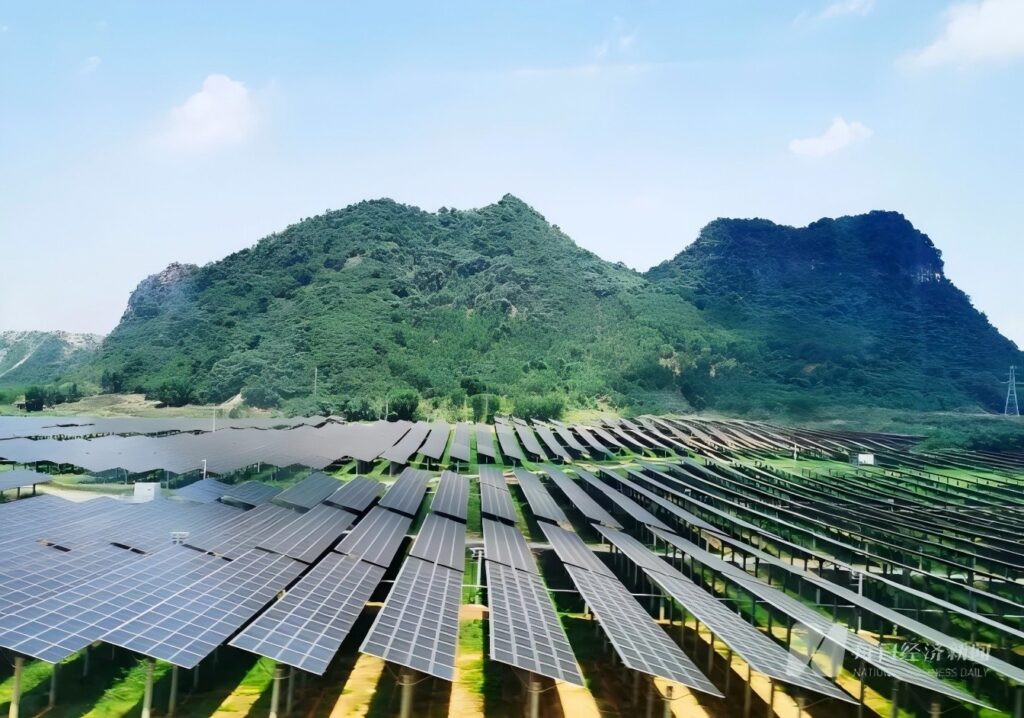China’s Energy Intensity Target Adjustment: From Efficiency Optimization to Absolute Emission Reduction
中国的能源强度目标调整:从效率优化到绝对减排
Introduction
China, the world’s largest energy consumer and carbon emitter, is navigating a complex path between economic growth and its ambitious climate commitments. Recent policy announcements and shifts in how the nation measures its energy performance reveal a pragmatic recalibration, highlighting both progress and persistent challenges in its journey towards carbon neutrality by 2060.
引言
作为全球最大的能源消费国和碳排放国,中国正在经济增长与宏伟的气候承诺之间探索一条复杂的道路。近期的政策公告以及国家衡量能源绩效方式的转变,揭示了一种务实的调整,这既凸显了中国在2060年实现碳中和征程中取得的进展,也反映了仍存在的挑战。
China’s Shifting Energy Intensity Targets: A Closer Look
Beijing has set a 3% reduction target for its economy’s energy intensity in 2025. This metric, which measures the amount of energy consumed per unit of Gross Domestic Product (GDP), is a crucial indicator of energy efficiency. While this 3% goal is slightly more ambitious than 2024’s 2.5% target, it remains lower than the impressive 3.8% drop recorded last year. Importantly, the government is simultaneously targeting overall GDP growth of about 5% for this year, underscoring the delicate balance between economic expansion and environmental goals.
However, a notable absence from the main government working report presented to the National People’s Assembly in March was a specific target for reducing emissions per unit of GDP. These “intensity targets” have historically been key signals of China’s long-term commitment to its ecological transition, with the ultimate aim of peaking emissions by 2030 and achieving carbon neutrality by 2060.
中国不断调整的能源强度目标:深入解析
中国政府设定了2025年单位GDP能耗(即能源强度)降低3%的目标。这一指标用于衡量单位国内生产总值(GDP)的能源消耗量,是反映能源效率的关键指标。尽管3%的目标略高于2024年2.5%的目标,但仍低于去年3.8%的显著降幅。值得注意的是,政府同时设定了今年约5%的GDP总体增长目标,这凸显了经济扩张与环境目标之间的微妙平衡。
然而,在3月提交给全国人民代表大会的政府工作报告主体内容中,一个明显的变化是未提及单位GDP碳排放降低的具体目标。这些“强度目标”历来是中国致力于生态转型的重要信号,其最终目标是到2030年实现碳达峰、到2060年实现碳中和。
The Fine Print: How China Measures Up
A significant development impacting these figures is a rule change implemented in late 2022. China’s energy intensity calculations no longer include renewables or energy used as industrial feedstock (like coal converted into chemicals). This effectively shifts the focus to “fossil energy intensity.” While this adjustment makes the targets easier to achieve on paper, analysts note it could potentially allow for an increase in overall CO2 emissions as renewable energy consumption grows without counting towards the intensity metric.
This change helps explain why, despite total energy consumption growing 5.7% in 2023 (faster than the 5.2% GDP growth), energy consumption per GDP under the new formula actually saw a 0.5% fall. Without this reclassification, the energy intensity figures would look considerably less favorable.
细则解读:中国的核算方式变化
影响这些数据的一个重要进展是2022年末实施的一项规则调整。中国的能源强度计算中,不再纳入可再生能源或用作工业原料的能源(如转化为化学品的煤炭)。这一调整实际上将核算重点转向了“化石能源强度”。尽管从表面上看,这一调整使目标更容易实现,但分析人士指出,随着可再生能源消费量增长却不计入强度指标,这可能会导致总体二氧化碳排放量上升。
这一变化也解释了为何2023年能源消费总量增长5.7%(增速高于5.2%的GDP增长),但按新公式计算的单位GDP能耗却实际下降了0.5%。若不进行这一重新分类,能源强度数据将会逊色不少。
Challenges on the Path to Efficiency
Achieving the 14th Five-Year Plan’s (2021-2025) overall energy intensity reduction target of 13.5% (from 2020 levels) appears challenging. Analysts suggest that a 3% reduction in 2025 alone might be insufficient to hit this cumulative goal, indicating that a more substantial annual drop (around 6%) would have been needed in both 2024 and 2025 to stay on track.
Several factors contribute to this difficulty:
• Post-pandemic economic recovery: The push for exports has fueled demand from energy-intensive industries.
• Emphasis on high-end production: While “high-end” might suggest efficiency, the rapid expansion of certain manufacturing sectors, including clean energy technologies (like batteries, electric vehicles, and solar equipment) and heavy industries (such as non-ferrous metals and chemicals), has driven up overall energy consumption. This growth in energy-intensive manufacturing has compensated for slower growth in less energy-intensive service sectors, making the economy’s structure more energy-intensive in the short term.
• Structural Economic Shift: China’s economy is still undergoing a transformation, and the initial energy demands of building out new, advanced manufacturing capabilities can be substantial, even if the long-term goal is a more efficient and cleaner industrial base.
效率提升之路上面临的挑战
要实现“十四五”规划(2021-2025年)中单位GDP能耗较2020年下降13.5%的总体目标,似乎颇具难度。分析人士认为,仅靠2025年下降3%,可能不足以达成这一累计目标。这意味着,若要按计划推进,2024年和2025年每年需实现更大幅度的下降(约6%)。
造成这一困境的因素有以下几点:
• 后疫情时代的经济复苏:对出口的推动刺激了高耗能行业的需求。
• 对高端生产的重视:尽管“高端”一词可能让人联想到效率提升,但某些制造业部门的快速扩张——包括清洁能源技术(如电池、电动汽车和太阳能设备)以及重工业(如有色金属和化工)——推高了整体能源消耗。高耗能制造业的这种增长,抵消了低耗能服务业增速放缓的影响,使得短期内经济结构的耗能程度更高。
• 经济结构性转变:中国经济仍在经历转型,即便长期目标是打造更高效、更清洁的工业基础,构建新的先进制造能力初期所需的能源消耗可能依然巨大。
Looking Ahead: A Pivotal Policy Shift
A major strategic shift is on the horizon. Starting with the 15th Five-Year Plan (2026-2030), China will fundamentally alter its environmental performance metrics. Energy intensity will be set aside as a primary metric. Instead, the main objective will transition to reducing emissions intensity, with a secondary goal for overall emissions. Furthermore, from 2031, overall (absolute) emissions will become the primary target, with emissions intensity taking a secondary role.
This planned transition towards absolute emissions targets marks a critical evolution in China’s climate governance. It signals a move beyond relative efficiency gains towards concrete reductions in total carbon output, a necessary step for achieving its 2030 peak emissions and 2060 carbon neutrality goals.
展望未来:关键的政策转变
一项重大的战略转变即将到来。从“十五五”规划(2026-2030年)开始,中国将从根本上调整其环境绩效指标。能源强度将不再作为主要指标,取而代之的是,主要目标将转向降低排放强度,同时将总体排放量作为次要目标。此外,自2031年起,总体(绝对)排放量将成为首要目标,而排放强度则退为次要角色。
这种向绝对排放目标的计划性转变,标志着中国气候治理的关键演进。这表明中国正从追求相对的效率提升,转向具体减少碳排放总量——这是实现2030年碳达峰和2060年碳中和目标的必要举措。
China’s Climate Ambition in a Global Context
Compared to other major economies, China’s climate efforts present a mixed picture. While it remains heavily reliant on coal, its dominance in renewable energy deployment is unparalleled. In 2023, China installed more solar PV capacity than the entire world in 2022 and added more wind power than any other country. Its share of energy from zero-carbon sources in its primary energy supply is comparable to the United States (around 18-19%).
However, when it comes to overall energy efficiency, the historical comparison shows a different story. Since 1990, while China’s GDP grew approximately 30 times and energy consumption 10 times (a 3x efficiency increase), the US saw its GDP grow 4.5 times while energy consumption only increased by 25% (an 18x efficiency increase). This highlights the significant room for further efficiency improvements within the Chinese economic structure.
China’s “target responsibility system” for environmental goals, where specific targets are assigned to sub-national governments, differs significantly from the more legislation-driven approaches seen in the European Union and the United States. This top-down approach can drive rapid deployment but also faces challenges in consistent enforcement and data transparency.
The shift towards absolute emissions targets from 2031 is widely seen as a positive and necessary step by global climate experts. It underscores China’s long-term commitment and acknowledges that while intensity reductions are valuable, ultimately, absolute cuts are required to stabilize global temperatures. The success of this ambitious transition will depend heavily on sustained political will, technological innovation, and a continuous rebalancing act between economic development and environmental stewardship.
全球视野下的中国气候雄心
与其他主要经济体相比,中国在气候方面的努力呈现出复杂的图景。尽管中国仍高度依赖煤炭,但其在可再生能源部署方面的主导地位无可匹敌。2023年,中国新增的太阳能光伏装机容量超过了2022年全球的新增总量,新增风电装机容量也超过了其他任何国家。在一次能源供应中,零碳能源所占比例与美国相当(约为18%-19%)。
然而,若从整体能源效率的历史对比来看,情况则有所不同。自1990年以来,中国的GDP增长了约30倍,能源消耗增长了10倍(能效提升3倍);而美国的GDP增长了4.5倍,能源消耗仅增长25%(能效提升18倍)。这凸显出中国经济结构在能效提升方面仍有巨大空间。
中国针对环境目标实行“目标责任制”,将具体目标分配给地方政府,这与欧盟和美国以立法为主要驱动的方式有显著差异。这种自上而下的方式能够推动快速落实,但在持续执行和数据透明度方面也面临挑战。
全球气候专家普遍认为,中国从2031年起转向绝对排放目标是积极且必要的一步。这既彰显了中国的长期承诺,也承认了尽管降低强度具有价值,但最终仍需通过绝对减排来稳定全球气温。这一宏大转型的成功,在很大程度上取决于持续的政治意愿、技术创新,以及在经济发展与环境治理之间不断实现平衡。
Conclusion
Looking ahead, China plans a significant shift. From 2026, energy intensity will be phased out as a primary metric. The focus for the next five-year plan (2026-2030) will be reducing emissions intensity, with overall emissions as a secondary goal. By 2031, overall emissions will become the primary target, signaling a direct approach to environmental impact.
结论
展望未来,中国计划实施一项重大转变。从2026年起,能源强度将逐步不再作为主要指标。下一个五年规划(2026-2030年)的重点将是降低排放强度,同时将总体排放量作为次要目标。到2031年,总体排放量将成为首要目标,这标志着中国在环境影响治理方面将采取更为直接的方式。
